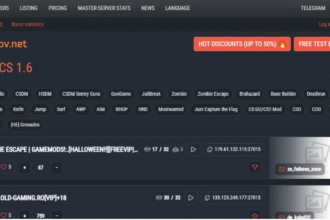Introduction
If you’re diving into the world of web development or just dabbling in server management, you may have come across the term “localhost.” But what does it really mean? And why is accessing it on port 127.0.0.1:49342 so crucial for your projects? Whether you’re troubleshooting a web application or testing out new features, understanding how to navigate localhost can unlock a realm of possibilities.
In this guide, we’ll unpack everything you need to know about localhost and specifically focus on port 127.0.0.1:49342—your gateway to effective local testing and development environments. Get ready to enhance your skills and make sure you’re fully equipped with the knowledge needed to harness the power of localhost effectively!
Understanding the Localhost and Port 127.0.0.1:49342
Localhost refers to your computer or device itself. It’s a way for software applications to communicate with each other locally, without needing an external network. When you hear “localhost,” think of it as your digital home.
The IP address 127.0.0.1 is the loopback address assigned to localhost. It serves as a gateway for connecting various services running on the same machine.
Port 49342 is simply one of many channels through which data can travel in and out of your system via localhost. Each port acts like a door that different applications use to send and receive information securely.
Accessing this specific port allows developers and users alike to test web applications in real-time, ensuring everything works correctly before going live online. Understanding these concepts forms the foundation for effective web development practices.
Why Accessing Localhost is Important
Accessing localhost is crucial for developers and testers. It provides a safe environment to run applications without affecting the live site. This isolation ensures that experimentation can occur freely.
Localhost acts as a personal server, enabling users to test code changes instantly. This immediate feedback loop helps identify issues early in the development process, making it easier to fix bugs before they reach production.
Moreover, working on localhost allows for enhanced performance testing. Developers can simulate various scenarios without external latency or network issues interfering with results.
For beginners learning web development, accessing localhost is essential. It offers hands-on experience in building and running applications locally before deploying them online.
Utilizing localhost fosters innovation while minimizing risks associated with public-facing servers. Its importance cannot be overstated in today’s fast-paced digital landscape.
Step-by-Step Guide to Accessing Localhost on Port 127.0.0.1:49342
Accessing localhost on port 127.0.0.1:49342 is straightforward. Start by opening your web browser of choice.
In the address bar, type in “http://127.0.0.1:49342” and press Enter.
If everything is set up correctly, you should see the application or page running on that specific port.
For those using command-line tools, you can also use cURL to check connectivity by typing `curl http://127.0.0.1:49342` into your terminal.
Make sure any necessary services are running on this port before attempting access.
Should you face difficulties loading the page, verify firewall settings or check if other applications might be blocking it.
Remember to ensure that no typos occur when entering the address; precision matters here!
Troubleshooting Common Issues
Accessing localhost on port 127.0.0.1:49342 can sometimes lead to unexpected hiccups. If you encounter a connection error, ensure your server is running properly. A quick restart might resolve the issue.
Another common problem arises from firewall settings blocking access to certain ports. Check your firewall rules and make exceptions for port 49342 if necessary.
You may also face issues if multiple applications are trying to use the same port. Use a tool like `netstat` to identify which services are currently utilizing that port and adjust accordingly.
If you’re still having trouble, clear your browser cache or try accessing it through another web browser entirely. Sometimes cached data can interfere with local connections.
Don’t forget about checking proxy settings as well; they can also redirect traffic away from localhost unexpectedly. Adjusting these settings could restore proper access quickly.
Utilizing Localhost for Web Development and Testing
Localhost is a developer’s playground. It allows you to create and test applications locally before deploying them online. Using 127.0.0.1:49342, you can run servers without affecting live environments.
Testing your code on localhost provides instant feedback. You can tweak settings and see immediate results, streamlining the development process significantly.
Moreover, local development helps in debugging issues effectively. By isolating your environment from external factors, you gain control over variables that might cause errors in production.
You also eliminate concerns about data loss or downtime during testing phases since everything happens within your local machine’s secure confines.
Whether you’re working with databases or frontend frameworks, utilizing localhost means faster iterations and enhanced creativity as ideas flow freely without external interruptions.
Security Measures when Using Localhost
When using localhost, security should always be a top priority. Although it may seem isolated from outside threats, vulnerabilities can still exist.
First, ensure your local firewall is active. This helps block unauthorized access attempts that could exploit open ports on your machine.
Regularly update your software too. Outdated applications often have known vulnerabilities that hackers can leverage to gain entry into your system.
Consider using strong passwords for any services exposed on localhost. Even if it’s just for testing purposes, weak credentials can lead to unexpected breaches.
It’s also wise to limit the applications running on 127.0.0.1:49342 only to what you need at the time. Reducing unnecessary exposure minimizes risk significantly.
Utilize HTTPS wherever possible when developing web applications locally. Encrypting data in transit safeguards against potential interception attacks even within a seemingly safe environment like localhost.
Conclusion
Accessing localhost on port 127.0.0.1:49342 is a straightforward process that can significantly enhance your development and testing experience. Understanding the basics of localhost, as well as the importance of this specific port, lays a solid foundation for any web developer or tech enthusiast.
Following the step-by-step guide ensures you navigate through potential challenges confidently. Troubleshooting common issues will help you maintain productivity without unnecessary interruptions.
Utilizing localhost effectively allows for real-time feedback during web development projects, making it an essential tool in your arsenal. Additionally, being mindful of security measures when using localhost protects both your work and personal data from potential threats.
By mastering how to access 127.0.0.1:49342, you’re not just improving your technical skills; you’re also enabling yourself to create more robust applications with ease.

















